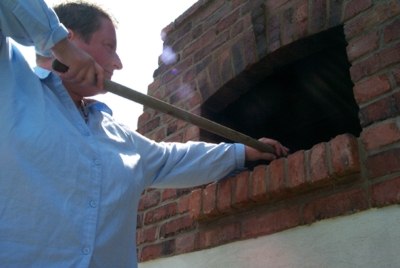THEY'RE LOVIN' THEIR OVEN IN POTTON
BY PHILLIP TODD
MANSONVILLE - Cooking the perfect tourtière du Lac St.-Jean is no easy feat. But professional chef Esther Fortin has finally cooked the succulent Québécois specialty of wild deer, partridge and hare to perfection - thanks to the only outdoor French-style traditional brick direct-fire oven in Quebec that now conveniently sits in her and Danielle Danis's Potton Township backyard.
"The longer it cooks, the better it tastes," said Fortin of the dish that normally cooks at low temperature for 10 to 12 hours. "In there it was perfect."
But cooking the perfect tourtière du Lac St-Jean is just the beginning for Fortin. She has big plans for her new toy. Fortin, who works winters as head chef at Glen Mountain Ski Resort, and up until recently as a summer day cook at Owl's Head Golf Club, wants to fashion a livelihood from the delights of her backyard brick oven.
By next summer, Fortin hopes to have a bakehouse and catering service up and running, and intends to offer cooking workshops "so once in your life you can cook bread in this special oven," she says.

Esther Fortin stokes the flames in her traditional European style direct-fire oven built in her backyard by oven master Marcus Flynn. Fortin, already a professional chef, will be learning to make artisanal bread at the prestigious Premiere Moisson bake school in Montreal.
"No one could offer the same thing in a comparable way," explained Marcus Flynn of Montreal, the oven-master who built the highly efficient cooker. Flynn built the structure using recycled late-19th century brick collected from Montreal's Plateau-Mont Royal neighborhood.
The oven uses a traditional European design whereby energy from wood fuel is accumulated in a four-by-three-foot interior baking chamber that is 15 inches high. The oven keeps its heat because there is only one opening into the baking chamber - the flue itself is located outside of the chamber on the other side of a "lip" that ensures that all the smoke from the burning wood - about two thirds of the energy contained in the wood - is burned before it can leave the chamber.
"It uses very little wood to reach its full temperature," said Flynn, "about an arm-load." Full temperature according to Flynn is around 600° C.
Heat slowly released
Once the oven is fired and reaches full temperature and the burnt wood is removed, the baking cycle begins, as the stored-up heat is slowly released from the chamber.
As the temperature in the baking chamber gradually drops, the oven can be used to cook different types of food. For example, at full temperature, the oven may be used to cook pizza or other fast-cooking foods, but low-temperature long-cooking dishes like tourtière du Lac St-Jean cannot be cooked in the oven until the baking chamber has cooled substantially later on in the baking cycle.
While Flynn has never built this type of oven outdoors, he has built Russian and Finnish masonry ovens, auxiliary ovens, and heaters all over Quebec that employ the same design principles. And as the cost of these ovens demonstrates, efficiency doesn't come cheap. Flynn valued the Mansonville cooker at roughly $15,000.
According to Flynn, the technology behind the highly efficient oven was developed 400 years ago in Northeastern Europe as a result of wood shortages caused by deforestation.
"It was essentially a question of survival," he said, explaining that usually several families would build one of these ovens at a point where several properties met. The ovens would be maintained communally and each family would contribute to its maintanance and supply it with fuel. A cooking schedule would be drawn up to meet the needs of the families.
And it is supplying a communal need for inexpensive baked goods, and authentic Québ´coise specialties that is fueling Fortin's business plan, one that she is confident will be a hit in Potton.
"When people hear about the oven, the first thing they ask me is 'Are you going to bake bread?' " she explains. "I'm sure it's going to work."